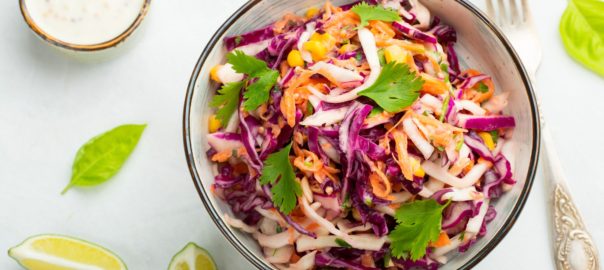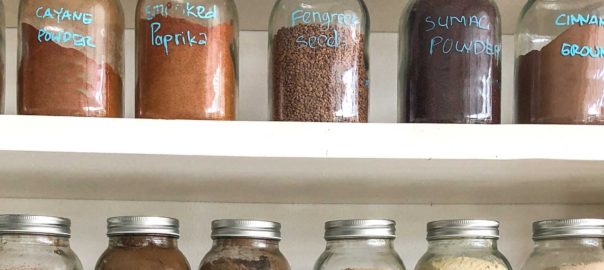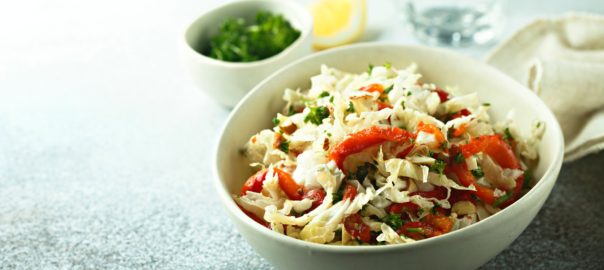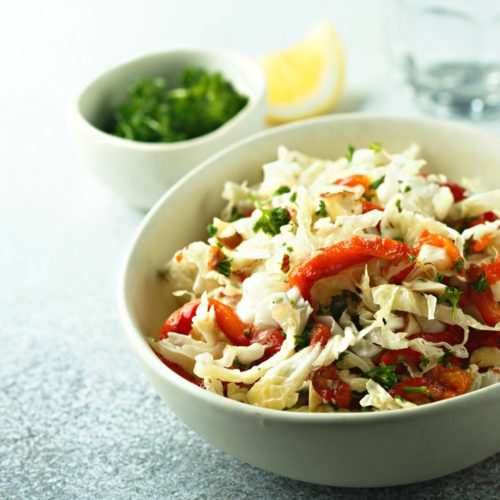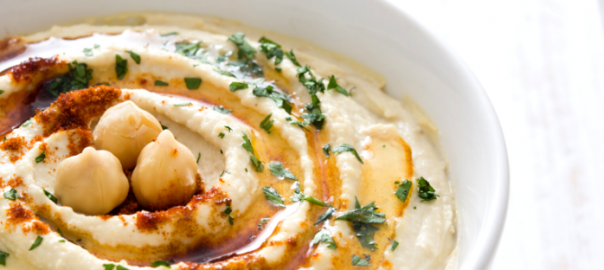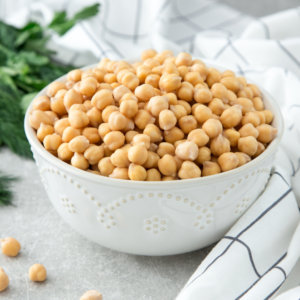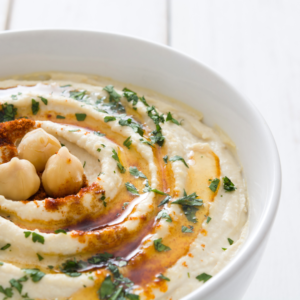Summer is a great time for eating lots of fresh veggies. Summer salads are a fabulous way to enjoy those veggies, it’s one of the reasons I deeply appreciate this season. Let’s be clear though, salad, in this case, doesn’t mean iceberg lettuce with some tomato and cucumber.
One of my favorite things to do in the summer is to have several different salads on hand. It helps to make mealtime quicker, and easier, and I know I’m getting a lot of veggies into my diet.
With multiple salads on hand you can have a quick meal ready at a moment’s notice. That’s because it’s super easy to make a composed plate with a protein and two to three different salads to round out a meal. It’s light, refreshing, and oh so delicious.
Below are a few of my favorite summer salads and you’ll notice not a single shred of lettuce in any of them. These particular salads are also pretty versatile. Steamed, cooled, broccoli or cauliflower could be a great addition. Zucchini, jicama, salad turnips, just use your imagination and see what you can create and how many veggies you can add to your plate.
One of my favorite ways to eat this delicious root is in an Oriental Salad. The tops of the root, the fatter part, tends to be milder in flavor so I use that when making this salad. The bottom of the root is great for pickling or stir-frying. I make this using the julienne blade on my Cuisinart.
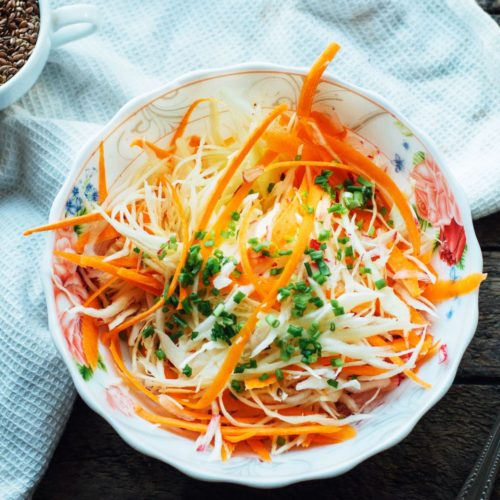
Daikon-Carrot Salad
Ingredients
- 1 C. julienned daikon root
- 1 C. julienned carrot
- 1 t. fresh grated ginger
- 1 T. rice wine vinegar
- 2 T. vegetable oil
- 1 t. sesame oil
- 1 t. tamari sauce
- 1 T. sesame seeds, toasted
- 2 t. ground nori (optional)
Instructions
- Whisk together the vinegar, tamari sauce, sesame seeds, nori, and ginger.
- Slowly whisk in the oils
- In a separate bowl toss together daikon and carrot
- Pour dressing over the vegetables and toss gently
- Marinate 30-45 minutes
- Can be served cold or at room temperatureEnjoy!
Wanting to make something fresh and different I rummaged around in my pantry and put together this amazingly delicious rice salad.
One of the great things about this dish is that it makes use of fresh vegetables and fresh herbs. I love salads like this, often preferring them the next day after the flavors have had a chance to meld and blend.
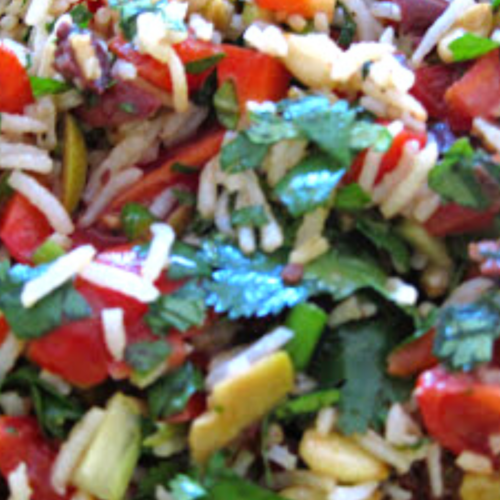
Mediterranean Rice Salad
Ingredients
- 1 cup cherry tomatoes, quartered
- 1 red sweet bell pepper seeded and diced
- 4 spring onions, diced
- 3 ribs celery, diced
- 1 cup assorted olives, diced
- 1/4 cup sun dried tomatoes in oil, drained and diced
- 1/2 cup pine nuts
- 1 bunch parsley, de-stemmed* and minced
- 1tablespoon minced basil leaves
- 4 cups cooked basmati rice
- 2 tablespoons olive oil
- 1 tablespoon red wine vinegar
- sea salt and fresh ground pepper to taste
Instructions
- Mix all ingredients together, toss well, let sit 2-3 hours for flavors to develop.Delicious!
Notes
- Leave the herbs bound together, wash well to clean and shake dry
- Holding the stems use a chef's knife and chop at the leaves in a short brisk fashion moving down the stems
- Rotate the stems and repeat on another side until all sides have been shaved
- Remove band holding the stems together
- Throw the stems in your compost bin
- Pile chopped leaves together and mince
A black rice with a rich delicious flavor, this is a whole grain and provides an antioxidant punch.
It provides a particular antioxidant called anthocyanin (which is also found in blueberries and blackberries) believed to help prevent inflammation, diabetes, and reduce or limit cancer-caused DNA damage.
Regardless of the health effects of the antioxidant properties there is no disputing the fact that this is a tasty way to add more whole grains to your diet.
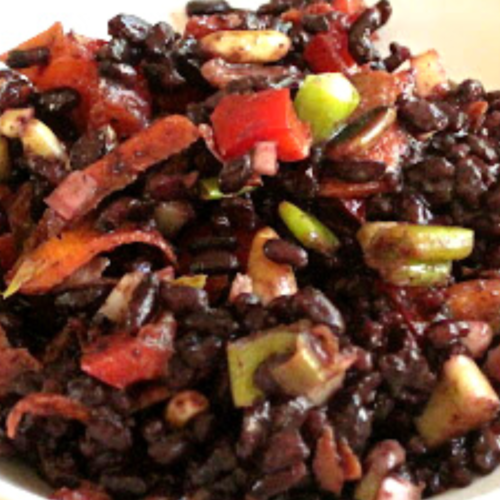
Forbidden Rice Salad
Ingredients
- 1 cup black rice
- 1 3/4 cup water
- 1/2 teaspoon sea salt
- 1/3 cup pine nuts
- 1 large carrot
- 1 rib celery leaves included
- 1 red bell pepper
- 3 spring onions
- 1 cup edamame
- 1 tablespoon olive oil
- 2 tablespoons walnut oil
- 1 tablespoon water
- 1 teaspoon dijon mustard
- sea salt and pepper
Instructions
- Put rice, water and salt into a pot and bring to just under a boil on the stovetopCover, reduce heat and cook until rice is done 20-25 minutes
- While the rice is cooking, toast pine nuts in a dry pan until just starting to turn brownRemove from heat and let sit
- Dice the vegetables except the edamameNote1 : I use the large shred on my box shredded to get large slivers of carrot rather than a dicecombine the vegetables together in a bowlNote 2: unfortunately I discovered I am out of edamame, the recipe really is better with them in there
- In a separate container whisk together the oils, vinegar, water, mustard, salt and pepperNote: I like to use walnut oil because it compliments the nutty taste of the rice and the flavor of the pine nuts
- When the rice is done uncover it, remove from heat and let it sit 10-15 minutes to cool off and to stop steamingCombine all ingredients together, toss well and refrigerate for 2-4 hours before serving
Salads are so wonderful in the warmer months, keeping a couple on hand in the fridge means you always have something for lunch or dinner.
If you don't happen to have fresh sprouts on hand you many grocery stores now carry them although they're certainly easy to make and I think it's better to get them fresh, it's certainly easy to do.
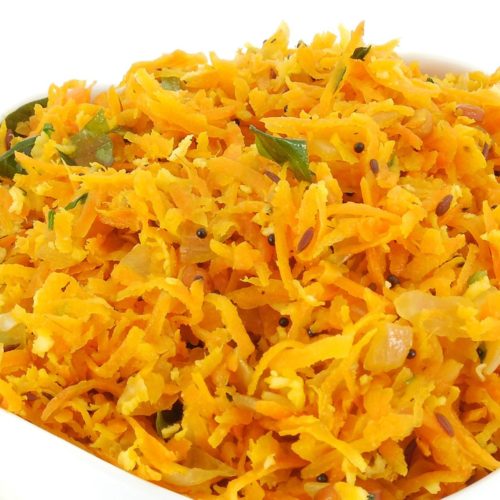
Curried Carrot Sprout Salad
Ingredients
- 6 large carrots, topped and shredded
- 1 C. fresh *bean sprouts
- 1/4 C. dried currants
- 1/4 C. raw sunflower seeds
- 1/4 C. chopped walnuts
- 1/2 C. mayonnaise
- 1 t. curry powder
- salt to taste
Instructions
- Mix all ingredients together
- Let sit in fridge for at least two hours to chill and for flavor to settle
Notes
- 1/2 C. assorted dried beans (I like adzuki, mung, lentil and black beans)
- Sort through beans and rinse
- Put in a metal pot, cover with water and set in the oven overnight (oven is off)
- In the morning drain and rinse the beans well
- Return to the oven
- Repeat until beans have 1/2″ long tails
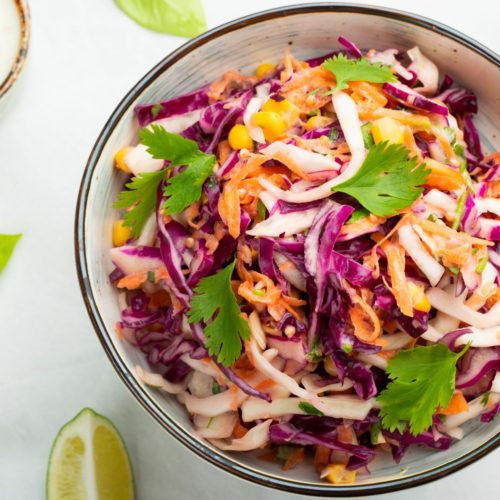
Salad With Tahini Dressing
Ingredients
- 2 Persian cucumbers, diced (about 1 cup)
- 1 carrot, grated (about 1 cup)
- 1/2 head radicchio, diced (about 1 cup)
- 2 cups shredded green cabbage
- 1/2 cup diced celery — tip I always simply cut through the entire bunch of celery. It’s faster and easier than dicing up the ribs
- 1/4 cup minced green onion
- 1/4 cup minced cilantro
- 1/3 cup raw cashews, minced
Instructions
- Toss with *tahini dressing and enjoy!
Notes
- 1/4 cup tahini
- 1/4 cup water
- Juice of one lemon, about 3 tablespoons
- One clove garlic, minced
- 1/2 teaspoon sea salt

